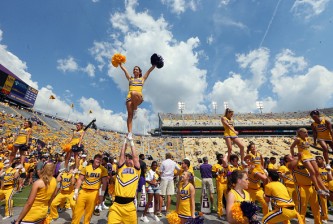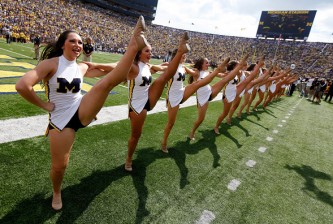I just love when Turner Sports is involved in a major sports property because it means plenty of press releases. With Turner on the NCAA Tournament, it means great releases like this one highlighting a conference call that took place shortly after the NCAA Tournament Selection Show. CBS’ Clark Kellogg and Greg Anthony were on the case as was Turner Sports’ Steve Kerr. Here’s a look.
Notes from CBS Sports and Turner Sports’ “NCAA Basketball Championship Selection Show” Conference Call – Sunday, March 13, 2011
The 2011 NCAA Division I Men’s Basketball Championship tips off with the FIRST FOUR on Tuesday, March 15 at 6:30 p.m. (ET) with UNC-Asheville vs. University of Arkansas-Little Rock, followed by the University of Alabama at Birmingham vs. Clemson. On Wednesday, March 16, the FIRST FOUR continues with the University of Texas at San Antonio vs. Alabama State at 6:30 p.m. (ET) followed by the University of Southern California vs. Virginia Commonwealth University.
TBS, CBS and TNT, will tip off their coverage beginning with the Second Round on Thursday, March 17, with games continuing to air on truTV.
PARTICIPANTS:
Greg Anthony, NCAA studio analyst
Clark Kellogg, NCAA game analyst
Steve Kerr, NCAA game analystKellogg on the New Orleans region being favorable for Pitt: “I actually tentatively ranked the regions and I thought Newark was number one (toughest). I thought that the New Orleans region had the least headwinds and ranked it fourth (toughest). BYU is certainly a different team than they were two weeks ago, due to the suspension of Brandon Davies. Wisconsin is a really solid team, but not overwhelming. Kansas State has found its groove and they’ve got a chance to make some noise. I thought the New Orleans region for Pitt had the least headwinds, there are good teams there, but I don’t think it’s quite the same as what you have in Newark or even Anaheim. I look at that New Orleans region as one that might be favorable for Pitt.”
Anthony on criticism people have on how the selection committee chooses the tournament field: “The reality is this, there is always going to be speculation at the bottom in terms of who got in and who did not. I think more than criticizing them, what it does is tell us what their thought process was in determining who they put in. What we often do when we’re speculating on these things is we focus on what our priorities are in terms of criteria. What you’ve got to understand is that each committee member prioritizes criteria differently. If I can’t compare apples to apples, if I’ve got a team that doesn’t necessarily play a lot of big time teams in the non-conference and obviously they are a mid-major and they are 10-2 on the road. That tells me that they are a really good team. It depends on what that individual committee member’s priority of criteria is. (People) are upset because it doesn’t match what their (criteria) is. They are telling you what’s important to them, they are telling you we want to see you play more competition outside of the conference. We all think differently. That’s why they’ve got 10 members in there.”
Kellogg on the four number one seeds of Ohio State, Kansas, Pitt and Duke: “Number one seeds, that was something that was debated throughout the weekend, who was going to be that fourth number one. I have no problem with it being Duke. The first two number ones were pretty much locked in, maybe as long ago as two weeks ago, when you talk Ohio State and Kansas. Pitt really had the inside track on being that third number one seed, by virtue of winning what was considered the toughest conference in the country. I didn’t have any issues. I also think the two line is pretty representative and balanced based on how teams did.”
Kerr on Ohio State playing in a difficult region: “What’s interesting, you look at Ohio State and they are the number one seed in the whole tournament and there’s no question they have a tougher region than everybody else. I’m sure they’re looking at the Southeast and Pitt and thinking, ‘I’d probably rather have that road.’ It’s a great bracket, but very rarely do one through four make it (to the Final Four), there are usually some upsets in there and you have to factor that in. Obviously, if you’re Ohio State you don’t have to play all those teams, you probably just have to play one of them if you go by history. You just have to take care of your own business if you’re Ohio State. They are playing in Cleveland to start out with, they should get through the first couple of games. At that point, everyone is going to have tough match-ups whether there are upsets or not. The one and done formula is always difficult because you’re playing good teams, you’re playing teams that can get hot, you may have a tough shooting night, but you just can’t look too far ahead against all these possible match-ups, you’ve just got to lock in the first one.”
Kerr on Duke’s travel not being favorable to them: “Duke gets the number one seed, and annually starts out in North Carolina. It always seems like there is some regional in North Carolina, but getting that number one seed and having to go all the way to Anaheim, I don’t know that that’s a favorable draw for Duke. I’m sure they like having that first seed, but to go all the way across the country and maybe play a San Diego State team, an hour and a half drive from Anaheim. I think travel is a pretty big deal in the tournament. I think teams want to stay as close to home as possible. I don’t think that is such an easy road for them.”
Kellogg on the FIRST FOUR match-ups: “The match-ups, you’ve got Clemson and UAB. Clemson a power conference team, and UAB a Conference USA team. I think those kind of match-ups are really interesting and should take place more during the non-conference schedule, some of those elite non-power conference teams playing teams that are in the middle of the pack from a power conference. I think those are interesting match-ups. How about USC and VCU? Another power conference team, Southern Cal, from the Pac-10, versus a team from the Colonial Athletic Association. I think those have the potential to be fantastic match-ups. The 16 seeds, even though they are setting up to play the number one seeds, the teams are evenly matched and extremely excited to play in the tournament, all for a chance to play a number one seed. I think there is potential for match-ups to be compelling.”
Kerr on whether the new format could have an impact for the teams playing in those opening round games: “What I’m excited to see is whether this (new format) affects what happens in the next round. Let’s say USC beats VCU, USC has got some players, they have some talent. Now when they move into the next round in Chicago and play Georgetown, do they have an advantage? Now they have their feet wet, maybe the butterflies are gone, a little momentum from a win, that’s what I’m most interested to see with this new format. Do some of those five and six seeds think, ‘now all of a sudden we’re at a disadvantage because this team comes in a little bit of a run?’ It’s a little bit like in the Big East, some of the double-bye teams have some problems because the teams that won for a couple of days come in with great momentum. We’ll see if that happens or not.”
Anthony on why Big East teams have not won the tournament recently: “I do think that with each passing year, in the last couple of years, there’s not as much separation between the ones and fours as there used to be. Those teams are getting closer and closer. The reality is that that (Big East) conference is just so difficult. It’s already tough to have to play on the road, but even if you play well you can lose. That’s what separates college basketball in a lot of ways. Before, when the really good teams went on the road, they had to play poorly to lose. Now they can play reasonably well and still lose games. That speaks to the parity. If you go back a couple of years ago to the great Kansas team that won it or when the North Carolina team won it, those one seeds those years were a notch above everyone else. I don’t think the Big East has had that type of team during the last couple of years. What makes the Big East great is not the top, it’s the totality. That’s what has been interesting and that’s also what sets them up to be disappointing when they get into the tournament because they expect those teams to overwhelm you. They are not those types of teams, they are just very consistent and they play a very competitive schedule.”
Anthony on the parity of college basketball: “I said this before we got to the conference tournaments, I felt like I would not be surprised to see about 18 teams who can make it to the Final Four. There really is about as much parity as we’ve had. It started last year, but this year really surpassed what we saw a season ago in terms of that parity.”
Kellogg on teams focusing too much attention on their competition compared to other regions: “You’ve got to play between the lines and if you’re overly concerned about what your potential match-ups might be, and how possibly unfair it could be than you’re not thinking about winning a championship. That’s my posture on it. You’d like to have it balance out, but there are a lot of things that factor into it. You’ve got to beat the teams that are in front of you and that’s what it’s about to win a championship. If you’re a championships caliber team than you handle it and make your way through it.”
That is all for this post.






















